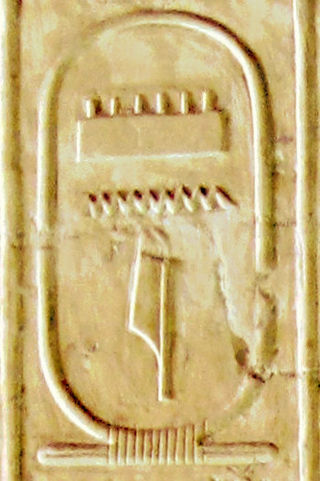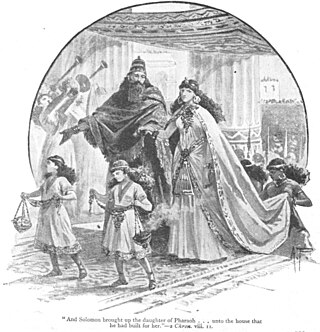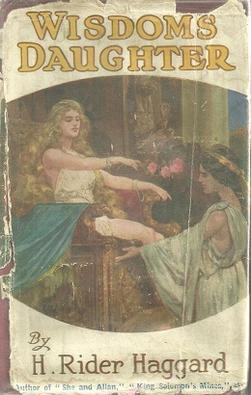
Joseph is an important Hebrew figure in the Bible's Book of Genesis and in the Quran. He was the first of the two sons of Jacob and Rachel. He is the founder of the Tribe of Joseph among the Israelites. His story functions as an explanation for Israel's residence in Egypt. He is the favourite son of the patriarch Jacob, and his jealous brothers sell him into slavery in Biblical Egypt, where he eventually ends up incarcerated. After correctly interpreting the dreams of Pharaoh, however, he rises to second-in-command in Egypt and saves Egypt during a famine. Jacob's family travels to Egypt to escape the famine, and it is through him that they are given leave to settle in the Land of Goshen.

Sarah is a biblical matriarch, prophet, and major figure in Abrahamic religions. While different Abrahamic faiths portray her differently, Judaism, Christianity, and Islam all depict her character similarly, as that of a pious woman, renowned for her hospitality and beauty, the wife and half-sister of Abraham, and the mother of Isaac. Sarah has her feast day on 1 September in the Catholic Church, 19 August in the Coptic Orthodox Church, 20 January in the LCMS, and 12 and 20 December in the Eastern Orthodox Church.

Menes was a pharaoh of the Early Dynastic Period of ancient Egypt, credited by classical tradition with having united Upper and Lower Egypt, and as the founder of the First Dynasty.

Neferkare Setepenre Ramesses IX was the eighth pharaoh of the Twentieth Dynasty of Egypt. He was the third longest serving king of this Dynasty after Ramesses III and Ramesses XI. He is now believed to have assumed the throne on I Akhet day 21 based on evidence presented by Jürgen von Beckerath in a 1984 GM article. According to the latest archaeological information, Ramesses IX died in Regnal Year 19 I Peret day 27 of his reign. Therefore, he enjoyed a reign of 18 years, 4 months and 6 days. His throne name, Neferkare Setepenre, means "Beautiful Is The Soul of Re, Chosen of Re." Ramesses IX is believed to be the son of Mentuherkhepeshef, a son of Ramesses III, since Mentuherkhopshef's wife, the lady Takhat bears the prominent title of King's Mother on the walls of tomb KV10, which she usurped and reused in the late 20th Dynasty; no other 20th Dynasty king is known to have had a mother with this name. Ramesses IX was, therefore, probably a grandson of Ramesses III.

Atenism, also known as the Aten religion, the Amarna religion, and the Amarna heresy, was a religion in ancient Egypt. It was founded by Akhenaten, a pharaoh who ruled the New Kingdom under the Eighteenth Dynasty. The religion is described as monotheistic or monolatristic, although some Egyptologists argue that it was actually henotheistic. Atenism was centred on the cult of Aten, a god depicted as the disc of the Sun. Aten was originally an aspect of Ra, Egypt's traditional solar deity, though he was later asserted by Akhenaten as being the superior of all deities. In the 14th century BC, Atenism was Egypt's state religion for around 20 years, and Akhenaten met the worship of other gods with persecution; he closed many traditional temples, instead commissioning the construction of Atenist temples, and also suppressed religious traditionalists. However, subsequent pharaohs toppled the movement in the aftermath of Akhenaten's death, thereby restoring Egyptian civilization's traditional polytheistic religion. Large-scale efforts were then undertaken to remove from Egypt and Egyptian records any presence or mention of Akhenaten, Atenist temples, and assertions of a uniquely supreme god.

Pharaoh is the fourth and last major novel by the Polish writer Bolesław Prus (1847–1912). Composed over a year's time in 1894–95, serialized in 1895–96, and published in book form in 1897, it was the sole historical novel by an author who had earlier disapproved of historical novels on the ground that they inevitably distort history.
Nitocris possibly was the last queen of the Sixth Dynasty of Ancient Egypt. Her name is found in writings long considered as relatively accurate resources: a major chronological documentation of the reigns of the kings of ancient Egypt that was composed in the third-century BC by Manetho, an Ancient Egyptian priest and by the ancient Greek historian, Herodotus, in his Histories. She is thought to be the daughter of Pepi II and Neith and to be the sister of Merenre Nemtyemsaf II.
"A Legend of Old Egypt" is a seven-page short story by Bolesław Prus, originally published January 1, 1888, in New Year's supplements to the Warsaw Kurier Codzienny and Tygodnik Ilustrowany. It was his first piece of historical fiction and later served as a preliminary sketch for his only historical novel, Pharaoh (1895), which would be serialized in the Illustrated Weekly.

Merneith was a consort and a regent of Ancient Egypt during the First Dynasty. She may have been a ruler of Egypt in her own right, based on several official records. If this was the case and the earlier royal wife Neithhotep never ruled as an independent regent, Merneith may have been the first female pharaoh and the earliest queen regnant in recorded history. Her rule occurred around 2950 BC for an undetermined period. Merneith’s name means "Beloved by Neith" and her stele contains symbols of that ancient Egyptian deity. She may have been Djer's daughter and was probably Djet's senior royal wife. The former meant that she would have been the great-granddaughter of unified Egypt's first pharaoh, Narmer. She was also the mother of Den, her successor.
Joan Marshall Grant Kelsey was an English writer of historical novels and a reincarnationist.

Mutnedjmet, also spelled Mutnodjmet, Mutnedjemet, etc., was an ancient Egyptian queen, the Great Royal Wife of Horemheb, the last ruler of the 18th Dynasty. The name, Mutnedjmet, translates as: "The sweet Mut" or "Mut is sweet." She was the second wife of Horemheb after Amenia who died before Horemheb became pharaoh.

Great Royal Wife, or alternatively, Chief King's Wife, is the title that was used to refer to the principal wife of the pharaoh of Ancient Egypt, who served many official functions.
The Saga of the Skolian Empire, informally called the Skolian Saga or Tales of the Ruby Dynasty, is a series of science fiction novels, novellas and novelettes by Catherine Asaro, revolving around characters from an interstellar empire known as the Skolian Empire and their power struggle with the rival Eubian Concord. The plot of the book unfolds over several generations of characters and revolves around political intrigues, but also contains subplots regarding physics, bio-enhancements, virtual computer networks, romance, mathematics, and military conflict as it is affected by superluminal space travel.

The Pharaoh's daughter in the story of the finding of Moses in the biblical Book of Exodus is an important, albeit minor, figure in Abrahamic religions. Though some variations of her story exist, the general consensus among Jews, Christians, and Muslims is that she is the adoptive mother of the prophet Moses. Muslims identify her with Asiya, the Great Royal Wife of the pharaoh. In either version, she saved Moses from certain death from both the Nile river and from the Pharaoh. As she ensured the well-being of Moses throughout his early life, she played an essential role in lifting the Hebrew slaves out of bondage in Egypt, their journey to the Promised Land, and the establishment of the Ten Commandments.

The Pharaoh's daughter is a figure in the Hebrew Bible who is described as marrying Solomon to cement a political alliance between the United Monarchy of Israel and Egypt.
The Quran contains references to more than fifty people and events also found in the Bible. While the stories told in each book are generally comparable, there are also some notable differences.

River God is a novel by author Wilbur Smith. It tells the story of the talented eunuch slave named Taita, his life in Egypt, the flight of Taita along with the Egyptian populace from the Hyksos invasion, and their eventual return. The novel can be grouped together with Wilbur Smith's other books on Ancient Egypt. It was first published in 1993, and was adapted for television alongside The Seventh Scroll as the 1999 mini-series The Seventh Scroll.

The Eighteenth Dynasty of Egypt is classified as the first dynasty of the New Kingdom of Egypt, the era in which ancient Egypt achieved the peak of its power. The Eighteenth Dynasty spanned the period from 1550/1549 to 1292 BC. This dynasty is also known as the Thutmoside Dynasty) for the four pharaohs named Thutmose.

Wisdom's Daughter is a fantasy novel by British writer H. Rider Haggard, published in 1923, by Hutchinson & Co in the UK and Doubleday, Page and Company in the US. It is the final published book in the Ayesha series but chronologically the first book in the series. Along with the other three novels in the series, Wisdom's Daughter was adapted into the 1935 film She.
Moses, Man of the Mountain is a 1939 novel by African-American novelist and anthropologist Zora Neale Hurston. The novel rewrites the story of the Book of Exodus of Moses and the Israelites from an Afro-American perspective. The novel applies a number of different motifs and themes commonly addressed in African-American culture, subverting the Moses story.














